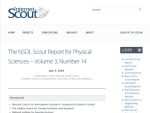Phosphorus in Soil and Water
Many waterways are considered polluted due, at least in part, to excessive amounts of phosphorus. This topic-in-depth delves into the issues surrounding phosphorus in the environment. First, Larry G. Bundy at the University of Wisconsin - Madison provides a slide show about phosphorus's presence in soils (1). Students can discover the agronomic need for phosphorus, its effects on water quality and management issues. The second web site, created by the University of Florida Cooperative Extension Service, offers a great overview of how wetlands affect the retention, cycling, and release of phosphorus in wetlands (2). Users will find a straightforward diagram of the phosphorus cycle in wetlands. Next, Manitoba Agriculture, Food, and Rural Initiatives present the reasons for careful management of phosphorus in fertilizers, manure, detergents, sewage, and industrial waste (3). The web site effectively summarizes how phosphorus gets into the surface water and negatively influences the environment. Developed by the USGS, the fourth web site addresses the pollution concerns surrounding agricultural landscapes (4). Visitors can learn about the amounts and effects of the erosion of phosphorus, as well as nitrogen and pesticides, on nearby streams and lakes. Next, the Minnesota Environmental Partnership discusses why Minnesota has restricted the use of phosphorus-containing fertilizers on lawns (5). Visitors can discover tips for buying fertilizers and how to deal with the leftovers. The sixth web site describes the USDA's Agricultural Research Service's findings that residue from water-treatment processes may increase soil's capacity to adsorb phosphorus (6). Users can discover how this may help reduce the transport of phosphorus into the watershed, especially in sandy soils. Next, the Australian Government's National Eutrophication Management Program presents its research examining phosphorus erosion, external things that affect its movement, predictive capabilities, and ways to reduce its movement (7). Visitors can learn about the researchers' discoveries that phosphorus can enter waterways through the subsoil. Lastly, the Minnesota Department of Agriculture describes the concept of a watershed and how they influence water quality (8). Users can find out how to reduce the amount of phosphorus entering nearby streams and lakes and how to help their watershed.
Alternate Title
1 "Understanding Soil Phosphorus"2 "Phosphorus Cycling in Wetlands"3 "Phosphorus in Soil and Water"4 "Water-quality patterns in agricultural areas"5 "What's in our Water - An Initiative of the Minnesota Environmental Partnership: Keeping Our Blue Waters from Turning Green"6 " Don't Waste this Stuff! Water - Treatment Residue May Ease an Environmental Concern"7 "National Eutrophication Management Program: Measurement and treatment of the movement of phosphorus through subsoils"8 "Watersheds, Lawn Care, and Water Quality"
Archived Scout Publication URL
Publisher
Classification
GEM Subject
Language
Date of Scout Publication
July 9th, 2004
Resource URL Clicks
1
Internal
Cumulative Rating
0
Resources




Comments